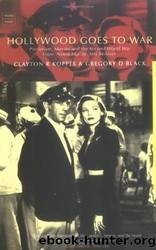Hollywood Goes to War : How politics, profits, and propaganda shaped World War II movies by Koppes Clayton R

Author:Koppes, Clayton R
Language: eng
Format: epub
Published: 2020-06-21T16:00:00+00:00
VII Putting the Russians Through the Wringer
War has put Hollywood’s traditional conception of the Muscovites through the wringer, and they have come out shaved, washed, sober, good to their families, Rotarians, brother Elks, and 33rd Degree Mason.
Variety, October 28, 1942
* * *
In late April 1943 four thousand people gathered in Washington, D.C., for a gala premiere of Warner Brothers’ proud new offering, Mission to Moscow. The crowd, composed of political figures, socialites, and hard-boiled journalists, enthusiastically hailed the picture. The public premiere followed a special private screening at the White House for President Franklin D. Roosevelt and his inner circle. A dramatization of the book of the same name by Joseph E. Davies, the United States ambassador to the Soviet Union from 1936 to 1938, the film skilfully combined fiction, half-truths, and documentary techniques. American-Soviet friendship stood at its height in the spring of 1943, the year the Red Army turned the tide on the Eastern front and Roosevelt, Churchill, and Stalin met for the first time, in Teheran. The film fed a genuine hunger on the part of millions of Americans to know more about their heroic but little understood and still mistrusted allies. To the Roosevelt administration, which had been deeply involved behind the scenes in the production of the film, Mission to Moscow would help bolster an uneasy alliance. The picture airbrushed out most of the nasty features of Stalin’s regime, delivered an all-out pummeling to American isolationists and British appeasers, and attributed an almost super human prescience about world affairs to Roosevelt, Stalin, and Joseph E. Davies.1
But the cheers that greeted the film’s premiere faded almost instantly. From the moment the picture went into general release it was surrounded by some of the bitterest controversy ever attached to an entertainment film. Upon reflection virtually no one believed Mission to Moscow rendered Soviet reality accurately—or even American politics faithfully. The film became the most notorious example of propaganda in the guise of entertainment ever produced by Hollywood. In 1947 Warner Brothers was so worried by the onset of the Cold War that it ordered all release prints destroyed. Yet during World War II the film had its share of passionate and highly placed defenders, if not for its accuracy then for its intentions.2
Although Mission to Moscow was the most blatant example, a pro-Russian picture became an indispensable proof of a studio’s sincerity towards the war effort. Practically every studio had its Russian film; most of them were released in 1943—early enough to capitalize on American gratitude for Soviet military successes and not so late as to be clouded by the growing fears of what those triumphs would mean for the postwar era. MGM offered a musical salute with Song of Russia; United Artists’ Three Russian Girls provided gender balance for Columbia’s Boy from Stalingrad. RKO completed a somewhat ambiguous Days of Glory in 1944, and Columbia weighed in with the last word, Counter-Attack, in 1945. However, Mission to Moscow and Samuel Goldwyn’s North Star were the two
Download
This site does not store any files on its server. We only index and link to content provided by other sites. Please contact the content providers to delete copyright contents if any and email us, we'll remove relevant links or contents immediately.
The Kite Runner by Khaled Hosseini(4435)
Gerald's Game by Stephen King(3918)
The Perils of Being Moderately Famous by Soha Ali Khan(3782)
Dialogue by Robert McKee(3582)
Story: Substance, Structure, Style and the Principles of Screenwriting by Robert McKee(2985)
The 101 Dalmatians by Dodie Smith(2936)
The Pixar Touch by David A. Price(2739)
Confessions of a Video Vixen by Karrine Steffans(2674)
Fantastic Beasts: The Crimes of Grindelwald by J. K. Rowling(2543)
How Music Works by David Byrne(2525)
Harry Potter 4 - Harry Potter and The Goblet of Fire by J.K.Rowling(2416)
Slugfest by Reed Tucker(2415)
The Mental Game of Writing: How to Overcome Obstacles, Stay Creative and Productive, and Free Your Mind for Success by James Scott Bell(2393)
Wildflower by Drew Barrymore(2117)
Scandals of Classic Hollywood: Sex, Deviance, and Drama from the Golden Age of American Cinema by Anne Helen Petersen(2109)
Casting Might-Have-Beens: A Film by Film Directory of Actors Considered for Roles Given to Others by Mell Eila(2071)
Screenplay: The Foundations of Screenwriting by Syd Field(2057)
Robin by Dave Itzkoff(2005)
The Complete H. P. Lovecraft Reader by H.P. Lovecraft(1976)
